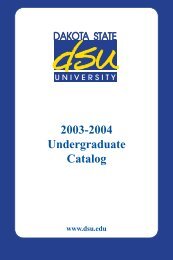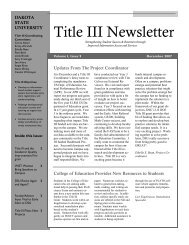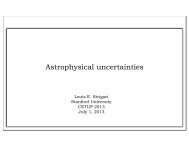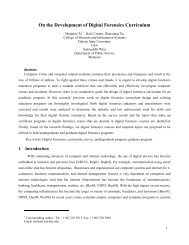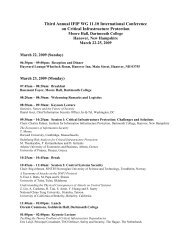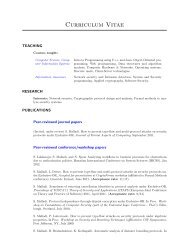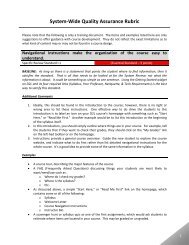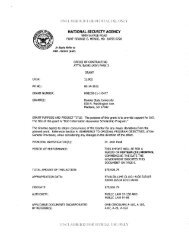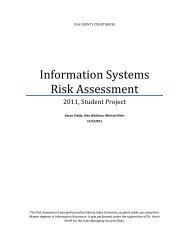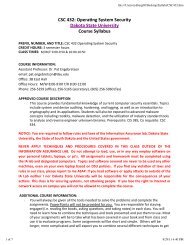Keith Dienes - Dakota State University
Keith Dienes - Dakota State University
Keith Dienes - Dakota State University
Create successful ePaper yourself
Turn your PDF publications into a flip-book with our unique Google optimized e-Paper software.
Dynamical Dark Matter<br />
A New Framework for DarkMatter Physics<br />
<strong>Keith</strong> R. <strong>Dienes</strong><br />
National Science Foundation<br />
<strong>University</strong> of Maryland<br />
<strong>University</strong> of Arizona<br />
Work done in collaboration<br />
with Brooks Thomas<br />
●<br />
●<br />
●<br />
●<br />
●<br />
●<br />
arXiv: 1106.4546<br />
arXiv: 1107.0721<br />
arXiv: 1203.1923<br />
arXiv: 1204.4183 (also with Shufang Su)<br />
arXiv: 1208.0336 (also with Jason Kumar)<br />
arXiv: 1306.2959 (also with Jason Kumar)<br />
Tucson, Arizona<br />
This work was supported in part by the National Science Foundation through its<br />
employee IR/D program. The opinions and conclusions expressed herein are those<br />
of the speaker, and do not necessarily represent the National Science Foundation.<br />
PPC 2013 Conference<br />
Deadwood, South <strong>Dakota</strong><br />
7/10/2013
Dark Matter = <br />
●<br />
●<br />
●<br />
●<br />
Situated at the nexus of particle physics, astrophysics, and cosmology<br />
Dynamic interplay between theory and current experiments<br />
Of fundamental importance: literally 23% of the universe!<br />
Necessarily involves physics beyond the Standard Model<br />
One of the most compelling<br />
mysteries facing physics today!
For such an important question, it is crucial that we not slip<br />
into simplistic thinking!<br />
What do we really know about the dark sector<br />
Let's reconsider the darkmatter problem from the<br />
beginning, without any theoretical prejudices!
Overall issue faced when proposing a darkmatter candidate: must<br />
constrain its abundance, its lifetime, or the relation between the two.<br />
Suppose only a single darkmatter particle <br />
● Must carry entire DM abundance: CDM = 0.23 (WMAP).<br />
●<br />
●<br />
●<br />
Given this large abundance, consistency with BBN, CMB, etc.<br />
requires that have a lifetime which meets or exceeds the current age<br />
of the universe (“minimally stable”) ~ 10 17 s.<br />
Actually, because of the quantummechanical nature of the decay<br />
process (not all DM decays at once), the lifetime of must exceed the<br />
age of universe by many orders of magnitude (“hyperstable”) ~ 10 26 s.<br />
Most DM scenarios take this form.<br />
Hyperstability is the only way in which a single DM candidate can<br />
satisfy the competing constraints on abundance and lifetime. Resulting<br />
theory is essentially “frozen in time”: CDM is constant, etc.
This is the standard paradigm which has dominated our<br />
thinking about the entire darkmatter question for<br />
many years.<br />
There is nothing wrong with this paradigm, and indeed<br />
it dovetails nicely with many of our preconceived<br />
notions about physics beyond the Standard Model...
Many theoretical proposals for physics beyond the SM give rise<br />
to suitable darkmatter candidates e.g.,<br />
●<br />
●<br />
LSP in supersymmetric theories<br />
LKP in (universal) higherdimensional theories in which the<br />
SM propagates in the extra dimensions<br />
In all cases, the ability of these particles to serve as darkmatter<br />
candidates rests squarely on their stability. This in turn is usually the<br />
consequence of a stabilizing symmetry e.g.,<br />
●<br />
●<br />
Rparity in supersymmetric theories<br />
“KK parity” in higherdimensional theories<br />
Indeed, any particle which decays too rapidly into SM states is likely to<br />
upset BBN and lightelement abundances, and also leave undesirable<br />
imprints in the CMB and diffuse photon/Xray backgrounds.
But why should dark matter consist of only one particle<br />
After all, the visible matter has much smaller abundance, yet is teeming<br />
with a diversity and complexity known as the Standard Model.<br />
Let's suppose the dark matter of the universe consists of N states,<br />
with N>>1 ... an entire ensemble of states!<br />
●<br />
●<br />
●<br />
●<br />
No state individually needs to carry the full CDM so long as<br />
the sum of their abundances matches CDM .<br />
In particular, each state can have a very small abundance.<br />
If all states share a common lifetime, then they must continue to<br />
be hyperstable in order to evade problems with BBN, CMB, ...<br />
We are back to the usual scenario.<br />
However, must these states really have the same lifetimes<br />
(After all, none of them is individually carrying the full<br />
darkmatter abundance any longer!)
A fundamental observation:<br />
A given darkmatter component need not be stable if its<br />
abundance at the time of its decay is sufficiently small.<br />
A sufficiently small abundance ensures that the disruptive effects<br />
of the decay of such a particle will be minimal, and that all<br />
constraints from BBN, CMB, etc., will continue to be satisfied.<br />
Thus we are naturally led to an alternative concept <br />
a balancing of decay widths against abundances:<br />
<strong>State</strong>s with larger abundances must have smaller decay widths,<br />
but states with smaller abundances can have larger decay widths.<br />
As long as decay widths are balanced against abundances across our entire<br />
darksector ensemble, all phenomenological constraints can be satisfied!
Thus, darkmatter stability is no longer required!<br />
This is Dynamical Dark Matter (DDM): a new framework for<br />
darkmatter physics in which the notion of darkmatter stability is<br />
replaced by a balancing of lifetimes against cosmological<br />
abundances across an ensemble of individual darkmatter<br />
components with different masses, lifetimes, and abundances.<br />
This is the most general dark sector that can be contemplated,<br />
and reduces to the standard picture of a single stable particle as<br />
the number of states in the ensemble is taken to one.<br />
Otherwise, if the number of states is enlarged, the notion of<br />
darkmatter stability generalizes into something far richer:<br />
a balancing of lifetimes against abundances. The dark<br />
sector becomes truly dynamical!
Moreover, each of these abundances will generally have its own<br />
timedependence through the evolution of the universe.... e.g.,
Dynamical Dark Matter<br />
Lifetimes balanced<br />
against abundances<br />
“staggered”<br />
turnon<br />
increasing mass<br />
Nothing special about<br />
the current time! Dark<br />
matter decays prior to,<br />
during, and after the<br />
current epoch, and<br />
forms a highly dynamic<br />
component of an<br />
evolving universe.
This is clearly a major reenvisioning of the dark<br />
sector, and calls for rethinking and reevaluating<br />
much of what we currently expect of dark matter.<br />
●<br />
●<br />
●<br />
●<br />
●<br />
●<br />
●<br />
KRD & B. Thomas, arXiv: 1106.4546<br />
KRD & B. Thomas, arXiv: 1107.0721<br />
KRD & B. Thomas, arXiv: 1203.1923<br />
KRD, S. Su & B. Thomas, arXiv: 1204.4183<br />
KRD, J. Kumar & B. Thomas, arXiv: 1208.0336<br />
KRD, J. Kumar & B. Thomas, arXiv: 1306.2959<br />
many more on the way...<br />
●<br />
●<br />
●<br />
●<br />
●<br />
●<br />
Darkmatter equation of state: do we still have w=0 No, much more subtle...<br />
Are such DDM ensembles of states easy to realize Yes! (extra dimensions; string<br />
theory; axiverse, etc. In fact, DDM is the kind of dark matter string theory gives!)<br />
Can we make actual explicit models in this framework which really satisfy every<br />
collider, astrophysical, and cosmological bound currently known for dark matter Yes!<br />
(and phenomenological bounds are satisfied in new, surprising ways)<br />
Implications for collider searches for dark matter Unusual and distinctive collider<br />
kinematics. Invariant mass spectra, MT2 distributions, ...<br />
Implications for directdetection experiments Distinctive recoilenergy spectra with<br />
entirely new shapes and properties!<br />
Implications for indirect detection e.g. positron excess easy to accommodate, with no<br />
downturn in positron flux expected... a “plateau” is actually a smoking gun for DDM!
Unlike traditional dark matter, DDM is not simply a property<br />
of the particle physics alone!<br />
Lifetimes<br />
(decay widths)<br />
balanced against<br />
Cosmological<br />
abundances<br />
determined by masses,<br />
couplings, in underlying<br />
Lagrangian i.e., particle<br />
physics considerations alone<br />
must be carefully<br />
balanced as well<br />
determined by interplay<br />
between Lagrangian parameters<br />
and cosmological history<br />
DDM rests upon a balancing between particle physics and<br />
cosmological history! Abundances need not even be set thermally.
Because of its nontrivial structure, the DDM ensemble unlike<br />
most traditional darkmatter candidates cannot be characterized in<br />
terms of a single mass, decay width, or set of scattering amplitudes.<br />
As a consequence, phenomenological bounds<br />
on dark matter in the DDM framework must<br />
be phrased and analyzed in terms of a new<br />
set of variables (e.g., scaling relations or<br />
other internal correlations or constraints)<br />
which describe the behavior of the entire<br />
DDM ensemble as a collective entity with its<br />
own internal structures and/or symmetries!<br />
e.g., Scaling exponents of abundances<br />
and density of states relative to widths<br />
e.g.,<br />
density of states per unit
DDM ensembles have a new (effective) equation of state!<br />
●<br />
●<br />
Indeed, one important signature of the<br />
dynamical nature of dark matter in this<br />
framework is that tot is a timeevolving<br />
quantity even during the current matterdominated<br />
epoch! DDM ensemble has a nontrivial<br />
effective equation of state!<br />
Within such a framework, it is therefore only<br />
an accident that tot happens to match the<br />
observed CDM =0.23 at the present time.<br />
● For :<br />
where<br />
● For :<br />
where
DDM has new ways of helping the dark sector stay dark!<br />
In many constructions, SM couples to<br />
only one particular combination of<br />
ensemble fields with different masses....<br />
However, once ' is produced<br />
(in laboratory, in distant<br />
astrophysical sources, etc.), it<br />
rapidly decoheres and does not<br />
reconstitute in finite time...<br />
This novel effect provides yet another<br />
mechanism which may help dark matter<br />
stay dark, and leads to different<br />
signature patterns from those which<br />
characterize traditional singlecomponent<br />
darkmatter candidates.<br />
KRD, E. Dudas, T. Gherghetta (1999)
At first glance, it might seem difficult (or at best finetuned) to<br />
arrange a collection of states which are not only suitable candidates<br />
for dark matter but in which the abundances and SM decay widths are<br />
precisely balanced in the required manner...<br />
However, it turns out that there is one group of states for<br />
which such a balancing act can occur naturally:<br />
An infinite tower of KaluzaKlein (KK) states living<br />
in the bulk of large extra spacetime dimensions!<br />
●<br />
SM restricted to brane all bulk states can interact with the<br />
SM only gravitationally natural candidates for dark matter!<br />
●<br />
From 4D perspective, this “dark matter” appears as infinite tower of KK states.<br />
●<br />
Moreover, a suitable balancing of KK abundances and lifetimes can easily occur<br />
even if the stability of the KK tower itself is entirely unprotected!<br />
Thus, a KK tower is a natural example of a DDM ensemble!
Specific DDM models exist which satisfy all<br />
known constraints: Consider 5D bulk axion<br />
with decay constant f X , corresponding to a<br />
general gauge group G with confinement scale G<br />
and coupling g G<br />
Our analysis then follows exactly<br />
as before, with the specific values<br />
Likewise, couplings to brane fields take the form...<br />
arXiv: 1107.0721<br />
arXiv: 1203.1923<br />
Such a choice is indeed gaugeneutral<br />
and wellmotivated<br />
theoretically, both in field theory<br />
and in string theory.<br />
brane mass comes from<br />
axion potential induced<br />
by instanton dynamics<br />
associated with group<br />
G at scale G<br />
We can then vary the free<br />
parameters (R, f X, G ) to<br />
survey different outcomes...<br />
(Indeed, only three parameters<br />
govern the entire KK tower!)
What are the phenomenological constraints that<br />
govern such scenarios<br />
arXiv: 1203.1923<br />
●<br />
GC (globular cluster) stars. Axions might carry away energy too efficiently,<br />
●<br />
altering stellar lifetimes. GC stars give most stringent bound.<br />
SN1987a. Same axions would effect energy loss rate.<br />
●<br />
Diffuse photon/Xray backgrounds. Axion decays to photons would leave<br />
unobserved imprints.<br />
●<br />
Eotvos. Cavenishtype “fifth force” experiments place bounds on sizes of extra<br />
spacetime dimensions.<br />
●<br />
Helioscopes. Detectors on earth measure axion fluxes from sun.<br />
●<br />
Collider limits. Constraints on missing energies, etc.<br />
●<br />
Overclosure. Too great a DDM abundance can overclose universe.<br />
●<br />
Thermal / cosmicstring production. Need to ensure that other production<br />
mechanisms not contribute significantly to relic abundances (so that misalignment<br />
production dominates).<br />
●<br />
CMB and BBN constraints must be satisfied. No significant distortions.<br />
●<br />
Isocurvature fluctuations must be suppressed. Critical issue for DDM ensembles.<br />
●<br />
Quantum fluctuations during inflation must not wash out DDM scaling structure.<br />
●<br />
Late entropy production. Must not exceed bounds.
Thus, within open regions of parameter space, this<br />
DDM model satisfies all known phenomenological<br />
constraints.<br />
This is therefore an “existence proof” for the<br />
phenomenological viability of the overall DDM<br />
framework.<br />
Indeed, theories of large extra dimensions and<br />
by extension, certain limits of string theory naturally<br />
and unavoidably give rise to DDM.<br />
DDM is precisely the kind of dark matter that<br />
string theory gives!
Experimental signatures of DDM<br />
How can we distinguish DDM...<br />
●<br />
●<br />
at colliders (LHC)<br />
at the next generation of directdetection experiments<br />
(e.g., XENON 100/1T, SuperCMS, LUX, PANDAX)<br />
... relative to more traditional darkmatter candidates<br />
KRD, S. Su, and B. Thomas, arXiv: 1204.4183<br />
KRD, J. Kumar, and B. Thomas, arXiv: 1208.0336
This can indeed be done both at collider experiments...<br />
DDM Models<br />
●<br />
KRD, S. Su, and B. Thomas, arXiv: 1204.4183<br />
●<br />
In many DDM models, constituent fields in the<br />
DDM ensemble can be produced alongside SM<br />
particles by the decays of additional heavy fields.<br />
●<br />
Evidence of a DDM ensemble can be ascertained<br />
in characteristic features imprinted on the<br />
invariantmass distributions of these SM particles.<br />
Traditional DM<br />
... and at directdetection experiments.<br />
●<br />
●<br />
KRD, J. Kumar and B. Thomas, arXiv: 1208.0336<br />
DDM ensembles can also give rise to<br />
distinctive features in recoilenergy spectra.<br />
These examples illustrate that DDM ensembles<br />
give rise to observable effects which can serve to<br />
distinguish them from traditional DM candidates.<br />
DDM<br />
Models<br />
Traditional DM
DDM also makes predictions for indirectdetection<br />
experiments...<br />
●<br />
KRD, J. Kumar & B. Thomas,<br />
arXiv: 1306.2959<br />
All curves also satisfy<br />
other constraints from...<br />
●<br />
●<br />
●<br />
●<br />
●<br />
Comicray antiproton flux<br />
(PAMELA)<br />
Diffuse gammaray flux<br />
(FERMILAT)<br />
Synchrotron radiation<br />
(e+/e interacting in galactic<br />
halo with background<br />
magnetic fields)<br />
CMB ionization history<br />
(Planck)<br />
Combined electron/positron<br />
flux (FERMILAT)<br />
DDM: Fully consistent with positron<br />
excess observed thus far [AMS02]<br />
DDM prediction: no<br />
downturn at higher<br />
energies! Flat plateau...<br />
A “smoking gun” for DDM!
We are only at the tip of the iceberg...<br />
Almost every traditional line of investigation in darkmatter<br />
physics can be reevaluated in this context<br />
(from structure formation to collider<br />
phenomenology, and everything in between).<br />
The Dynamical Dark Matter framework is rich and<br />
we have only begun to explore its properties.<br />
DDM provides new ways to think about old<br />
problems and challenges in darkmatter physics.
But most importantly...<br />
The TakeHome Message<br />
Dynamical Dark Matter is the most general way of<br />
thinking about the dark sector...<br />
●<br />
●<br />
●<br />
Stability is not a fundamental requirement for the dark sector.<br />
All that is required is a phenomenological balancing of lifetimes against<br />
abundances.<br />
The resulting physics can satisfy all astrophysical, cosmological, and<br />
collider constraints on dark matter, and yet simultaneously give rise to new<br />
theoretical insights and new experimentally distinct signatures.<br />
It is time we shed our theoretical prejudices and embrace all the<br />
possibilities that darksector instability allows!



